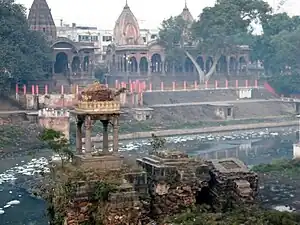Kanh River
Kanh is a river flowing through Indore, the largest city in the Indian state of Madhya Pradesh.[1] The river started carrying sewage in the early 1990s. Several attempts have been made to clean the river, yet it remains polluted.[2]
| Kanh river | |
|---|---|
 The polluted Kanh river in Indore, 2009. | |
| Native name | Kanh river (Sanskrit) |
| Location | |
| Country | India |
| State | Madhya Pradesh |
| Cities | Indore |
| Physical characteristics | |
| Source | |
| • location | Indore, India |
| Mouth | Saraswati river |
• location | Indore, India |
• coordinates | 22°43′07″N 75°51′31″E |
| Length | 21 km (13 mi) |
The river, along with the Saraswati River, is a part of the Smart City Indore project, and a riverfront spanning 3.9 kilometres has already been developed along the river.[3] Both the rivers are being rejuvenated under the Smart Cities Mission.[4]
Etymology
The name 'Kanh' is a cognate of Kanha, a major hindu deity, acquired after schwa deletion.
Corruptions of the name include Kahn and Khan, often used due to being easier to speak.
Pollution and environmental concerns
Kanh has faced massive pollution due to the flow of sewage from industries. As an additional load, the household drainage is also dumped into the Kanh without any purification or cleaning.[5]
Rejuvenation
In 2015, the Indian government announced the Smart Cities Mission. Indore successfully qualified in its Phase-1, and it ranked eleventh in the list released by Union Minister Venkaiah Naidu (MoUD), becoming one of the first twenty cities to be developed as a 'Smart City'.[6] An amount of Rs 39 crores had been spent till 2020 on the Kanh and Saraswati riverfront development, marking the completion of five out of eight stages of the riverfront's development.[4]
In 2023 the Union government sanctioned Rs. 511.15 Crore for the cleaning of the Kanh and Saraswati rivers, under the 'Namami Gange Programme’. Constructions undertaken using these funds are expected to be completed in the next two years.[7]
Course
Kanh rises from the Kakri Bardi hills which is also the source of the Shipra River. It later joins Saraswati, which further joins Shipra, then Chambal, then Yamuna and finally into the Ganga river.[5]
See also
References
- "जागरण स्पेशल: इंदौर ने लिखी नदी पुनर्जीवन की नई कहानी". Dainik Jagran (in Hindi). Retrieved 2023-04-18.
- "Madhya Pradesh to form task force to clean Kanh & other rivers". The Times of India. 2019-03-05. ISSN 0971-8257. Retrieved 2023-04-24.
- National Institute of Urban Affairs. ""Riverfront Development – Indore"". Retrieved April 4, 2021.
- ""Smart City spends Rs 660 cr in Indore's development"". The Free Press Journal. Retrieved April 4, 2021.
- "The story of Kanh: A river swallowed by the spreading city of Indore". CatchNews.com. Retrieved 12 December 2018.
- "List of first 20 smart cities under Smart Cities Mission". The Hindu. Retrieved February 16, 2016.
- "511 cr for pollution check in city rivers". The Times of India. 2023-02-24. ISSN 0971-8257. Retrieved 2023-02-24.